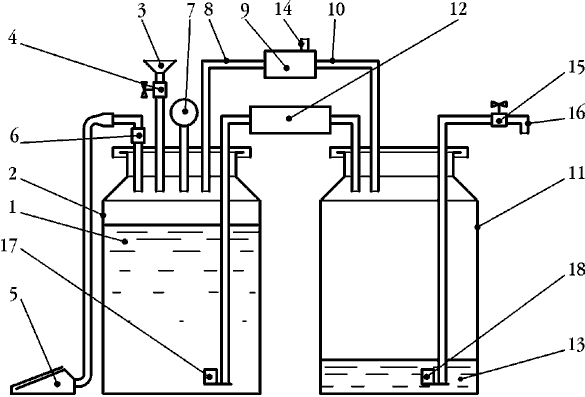|
Autonomic Water (Liquid) Purification System
Kazak State University, Kazakhstan
X-Master, Inc., New Hampshire, USA
Aliya Nurtaeva, Danko Priimak, Mikhail Nauryzbaev,
Aytbala Tumanova, Valeri Svetov
Patent Application filed in Kazakhstan,
priority date 12/27/00,
state registration # 2000/1374.1, patent approved on 09/24/01 by KazPatent
-self-sufficient, does not require special water pumping system, operable without any
additional source of energy
-hermetic, prevents polluting during purification process
-possible to use not only for purification of water, but liquids in general as well: aggressive, volatile, poisonous
-based on standard filters, which are replaceable
-easy to manufacture
BACKGROUND OF THE INVENTION
This invention relates to apparatus in chemical engineering, particularly, to the methods of purifying water (liquids). It is designed to purify water from natural sources, e.g., to obtain drinking water in the absence of any energy sources for water pumping. The invention might be used also for purifying some volatile liquids.
Patents, pertinent to the present invention include Kentwood, US Patent No. 5,698,091, disclosing water purification system with radiation source used for automatic monitoring the process; Newman, US Patent No. 1,418,013, disclosing an improvement in water purification by treating same with an alkaline bleaching agent and a coagulant; Langelier, US Patent No. 1,465,173, disclosing a water purification method, involving treatment using a minimum dosage of coagulant in combination with an acid to yield ionic hydrogen and improved coagulation; Mallory, US Patent No. 2,138,349, disclosing a method and apparatus for aerating sewage using a series of internal rotating diffusing baffels; Riddick, US Patent No. 3,075,645, disclosing a water treatment system, whereby coagulant is added to the water, the mixture is aerated and then passed through a flocculation basin, then filtered; Horuguchi et al, US Patent No. 3,547,816, disclosing an aerating and filtering water purification system; Edwards, US Patent No. 3,772,188, disclosing a waste water treatment system using pressurized oxygen injection; Pradt, US Patent No.3,876,536, disclosing a high temperature and high pressure wet air oxidation process for treating waste water; and Reimann, US Patent No. 4,029,574, disclosing a process for aerating organically contaminated sewage with oxygen.
It is well known water purification system comprising open vessel with funnel and paper filter. The liquid to be purified is placed on the filter and passed through the filter under its own gravitation, being collected in another vessel.
The shortcomings of this system are the following:
-change in technical conditions of water purification while the decreasing of liquid volume (height of water column) in the funnel, namely, lowering of water pressure in the funnel in filtration process;
-multi-stage, intermittent process, requiring repeated procedure of filling out the funnel by liquid;
-low and uncontrolled rate of the process.
The above mentioned shortcomings are absent in the system of water purification using tap water supply as water pumping system, filter and open reservoir to collect water after purification, where the constant pressure on the filter is provided by the extent to which a faucet valve is opened. This system however cannot be used in the absence of tap water supply or any energy sources, necessary for water pumping. The other shortcoming arises from the fact that reservoir is open: possibility of interaction of purified water, collected in it, with surroundings (contamination, evaporation, chemical reactions with air components).
GOAL OF THE INVENTION
The goal of this invention is to provide self-sufficiency of water purification system, possibility of purification of aggressive, volatile, poisonous liquids, to maintain optimal purification conditions during the purification process, and to increase purification efficiency (side positive effect).SUMMARY OF THE INVENTION
The said goal is achieved by using hermetic reservoirs, the first one as water pumping apparatus and the second one as receiving reservoir, both filled by purifying liquid and compressed gas and connected with each other through pressure stabilizer. Hermetically sealed reservoirs allow to create in them an excess of gas pressure which provides feeding of purifying liquid onto the filter and facilitates collection of purified liquid. Pressure stabilizer maintains the constant difference in gas pressure in both reservoirs, the value being chosen on the basis of optimal conditions of purification process.
DETAILED DESCRIPTION OF THE INVENTION
FIG. 1

Fig.1 is a schematic representation of the preferred embodiment of water (liquid) purification system. The liquid to be purified (1) is being placed into hermetic reservoir (2) through branch pipe and open valve (4), the valve being closed thereafter. Using air pump (5), air is being compressed through back valve (6) in the reservoir (2) over purified liquid up to pressure P1, indicated my manometer (7) and then is pumped through pipe (8) onto differential pressure stabilizer DPS (9). DPS (9) allows air to pass from pipe (8) to pipe (10) if the difference between pressure P1 in pipe (8) and P2 in pipe (10) corresponds to the value P3, defined by technical parameters of pressure stabilizer. Further, the air is passing into hermetic reservoir (11), filling it and creating pressure P2 in it. Purifying liquid under constant pressure P3 is flowing from reservoir (2) to reservoir (11) through filter 12, having been purified. While liquid volume in reservoir (2) decreases, the volume of compressed air increases, which causes lowering of pressure P1. Simultaneously, increasing volume of purified liquid (13) in the reservoir (11) gives rise to decrease in air volume over liquid, that is to increase in pressure P2. Both these processes lead to lowering of pressure P3. If the pressure P3 drops lower than parametric value, DPS (9) allows air to pass from reservoir (11) through pipe (10), valve of DPS (9), branch pipe (14) into the atmosphere. Air pressure in reservoir (11) decreases, causing the difference in pressure in reservoirs (2) and (11) to increase, as the result of it, the given value of pressure P3 is reestablished
In order to collect purified water (13) from reservoir (11), the valve (15) is to be opened and water (liquid) under pressure P2 flows out from branch pipe (16). This is followed by decrease in pressure P2 and increase in pressure P3. Increasing of pressure P3 causes DPS (9) to operate. Air from reservoir (2) passes via valve of DPS (9), pipe (10) into reservoir (11), thus increasing pressure P2. Pressure P3 returns to the initial value.
In order to exclude failures in operation of system due to air leaking from reservoir (2) through filter (12) after purification of the total volume of unpurified liquid (1) or due to air leaking from reservoir (11) via valve (15), branch pipe (16) after the total volume of purified water has been collected, float valves (17) and (18) are used. When water (liquid) level reaches minimal acceptable value, float valves (17) and (18) get closed.
The function of differential pressure stabilizer and the influence of P1/P2 ration on pressure P3 may be illustrated on the following numerical example.
Let the pressure of air compressed in the first reservoir is equal P1=2 atm, and pressure stabilizer is set up at value P3=0.5 atm. Then, the pressure in the second reservoir will be P2=P1-P3=1.5 atm. Thus, the function of pressure stabilizer ¢ to hold the constant difference in pressure P1 and P2. Therefore, P3=P1-P2=const=0.5 atm.
Let P1 is decreased by 0.01 atm, that is P1=2-0.01=1.99 and P2 is increased by 0.01 atm, that is P2=1.5+0.01=1.51,
Then P3=1.99-1.51=0.48 (instead of 0.5)
If the pressure P2 drops, P3 is increased, why?
Let P1=1.99; P2=1.51; P3=0.48. Let drop pressure P2 by 0.02 atm, then
P2=1.51-0.02=1.49 and P3=(1,99-1,49)=0,5 (instead of 0.48).
CLAIMS
1. An autonomic liquid purification system, comprising
-a water pumping device operated under the pressure;
-a filter;
-a reservoir for receiving and storing purified water, d i f f e r i n g
in that the water pumping device operable under the pressure and the receiving reservoir are made as hermetic tanks, connected with each other by two channels: aerial, through the pressure stabilizer and hydraulic, through the filter.
2. The water purification system as in claim 1, d i f f e r i n g
in that an input of hydraulic connection channel and input of a drain component are further provided with float valves.
|
